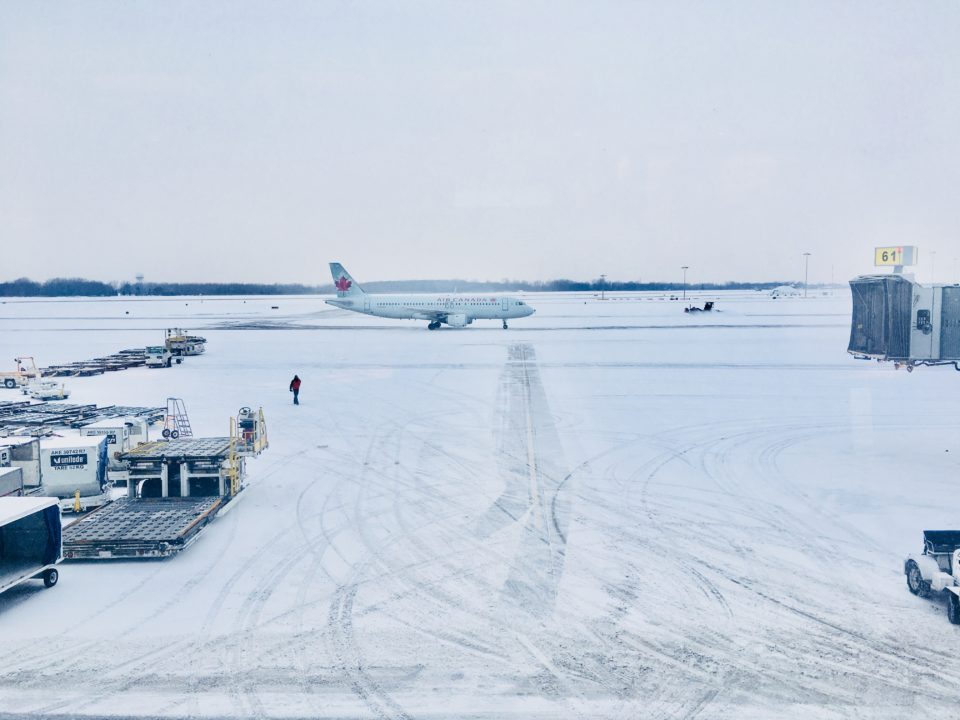Whether you’re a ski bum, snowbird, off-season adventurer, or all-season road warrior, your travel plans have you flying during the winter. And while you may love a wintertime trip (raises hand), flying in the colder months presents its own set of unique challenges.
Challenges like, dealing with winter storms—and the flight delays and cancellations that follow; getting stuck at a layover airport (whether by snow, delayed flights, or something else); adjusting your other bookings—like, a pre-booked COVID-19 test—to accommodate changed travel plans; and even what to pack (and what not to) for a wintry destination.
The best way to overcome the above challenges is to anticipate them—and plan ahead. Use these four tips to help you feel as prepared as possible for flying during the winter months.
1. Book direct flights when you’re flying during the winter
For example, if you’re flying from LAX to JFK, choose a direct flight over one that stops at, say, O’Hare.
Here’s why: We all know winter weather increases the potential for flight delays and cancellations. Add to that multiple cities and flights, and you’re increasing your chances for one of those flight plans to be interrupted.
And while business travelers don’t always have a say as to where a business trip takes you, you can increase your chances of an on-time arrival if you aren’t stopping somewhere winter-storm prone on a layover.
Read more: 6 Tips for Traveling During the Winter
If possible, book your direct flights via larger airports (versus smaller or alternate airports), as well. Bigger airports mean more airlines and more flights—a formula that will hopefully increase your chances of getting out if you experience a delay or have to rebook. It can also help to book early morning flights, as those are the least likely to be delayed by air traffic.
2. Know your options if your flight is delayed or canceled
Despite your best booking intentions, you might still experience winter weather-related flight delays or cancellations. Now what?
If your flight is substantially delayed or canceled, there are some steps to take right away.
If you’re at the airport:
- Get in line to talk to the terminal airline service representative. They may be able to quickly rebook you on the next available flight.
- While you’re waiting, check the airline’s app/website. You may be able to rebook with a few easy taps or clicks.
- You can also call the airline’s customer service number.
- TripIt Pro users: Consult Alternate Flights to find other flight options, including those on other airlines.
If you’re at home/not yet en route to the airport, consider options #2-4 above.
Tip: TripIt Pro members receive flight alerts about delays and cancellations quickly—often before the airline provides an update. While the app can’t predict when the next winter storm will hit, it will provide you with the most up-to-date information regarding delays, cancellations, and your options for alternate flights.
Keep in mind that if your travel plans include a layover, a delay could mean a possible missed connection. If this happens, the airline should rebook you on the next available flight. If it’s not until the next morning, the airline may provide you with accommodations and/or meals.
3. Be ready to adjust your other travel bookings
A flight is oftentimes just one of the many parts of a trip. Meaning, a canceled flight might impact when you can pick up your rental car, check into your vacation rental, and so on. Once you’ve handled rebooking your flight (or made other plans for getting to your destination), be sure to adjust your other reservations, as needed.
For example, if you need to show a negative COVID-19 test result for a test taken within 24 hours of arrival, or you booked one for when you would arrive, consider if you would need to take another test or rebook your appointment.
Tip: TripIt Pro users can consult Interactive Maps to find COVID-19 testing sites in the airports you’re traveling through.
4. Plan ahead, pack smart, and be patient
Delays and cancellations aside, flying during the winter calls for its own set of travel hacks. Here are a few you might find useful as you plan and pack for your wintertime trip.
- Track your flight, starting before you leave for the airport. You can keep an eye on your flight with alerts via TripIt Pro or by checking your airline’s app.
- If you’re packing a checked bag for a wintry destination, plan to wear (or carry on) your heavy items (e.g., winter coat, snow boots) to save on weight (and space!) in your suitcase.
- If you’re planning to fly from a cold-weather destination to a warm one, you might not need your winter coat once you arrive for your outbound flight. Some airports offer the ability to check your coat for the duration of your trip—saving you the need to lug it back and forth, and precious space in the overhead bin.
- Pack your patience. Flying during the winter might mean you experience longer lines at the check-in counter, airport security, and even at your go-to airport coffee shop. Be patient with airline and airport staff; everyone is doing their best. And a friendly attitude can go a long way—especially if you want to be rebooked on the next available flight home.













